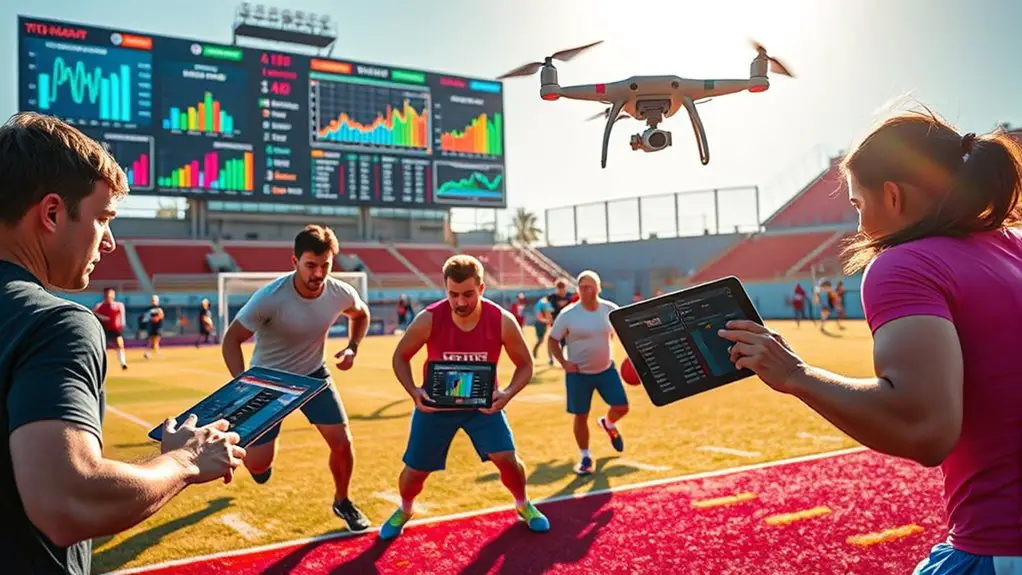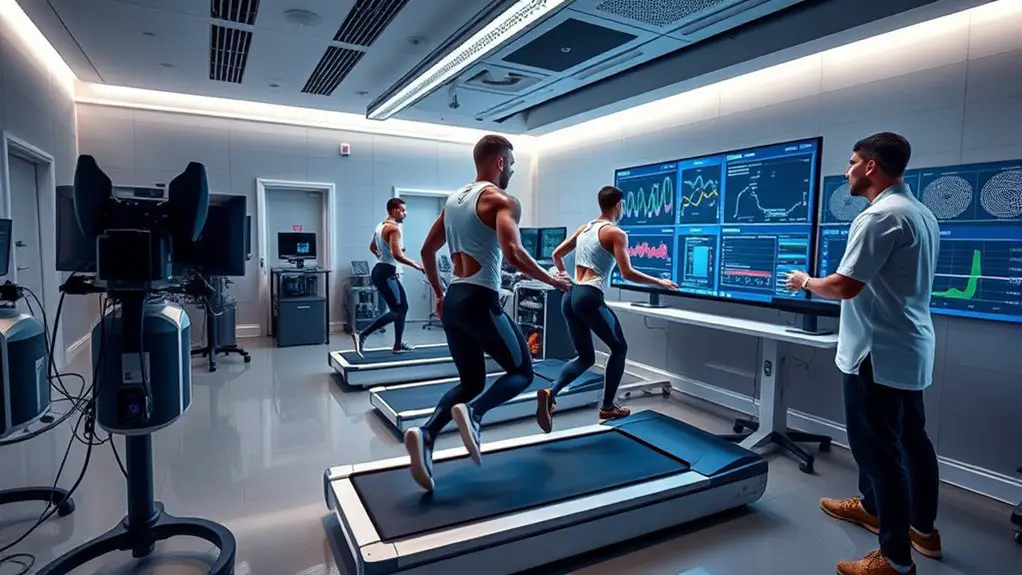Predictive analytics in sports performance turns raw data into valuable insights for athletes and coaches. It helps you understand performance through metrics like speed and efficiency, and offers real-time feedback for strategy adjustments. Wearable technology and sensor data capture crucial information, enhancing your training and game plans. With a focus on improving athlete performance, it also addresses ethical considerations in data privacy. There's a lot more to explore about how this science is shaping the future of sports.
Understanding Predictive Analytics in Sports
As you immerse yourself in the world of sports, understanding predictive analytics can greatly enhance your appreciation of the game. By leveraging data visualization tools, you can see patterns and trends that may not be immediately obvious. Imagine analyzing an athlete's performance metrics; this isn't just number crunching. It's about athlete profiling—understanding their strengths, weaknesses, and potential for improvement.
Predictive analytics allows you to forecast outcomes based on historical data. You'll be able to anticipate how a player might perform in future games or how a team could fare in a season based on previous statistics. This knowledge empowers you, giving you a deeper connection to the sport. Instead of passively watching, you're actively engaging with the game, making informed predictions, and enjoying a richer experience. Embrace this freedom of understanding, and let it transform how you view sports.
The Role of Data Collection in Performance Analysis
When it comes to performance analysis, data collection is essential for understanding how athletes perform. You'll find various performance metrics that can be tracked using advanced technology, allowing for real-time analysis that helps coaches and players make informed decisions. Let's explore the different types of metrics and tools that enhance performance evaluation. Additionally, by leveraging real-time analytics, teams can continuously adjust their strategies to optimize athlete performance.
Types of Performance Metrics
While various performance metrics exist, understanding which ones to focus on can greatly enhance your analysis of athletes' capabilities. Key metrics, like speed, endurance, and strength, provide a foundation for performance enhancement. You can use metric comparison to identify areas needing improvement and apply statistical modeling for deeper insights. Athlete evaluation becomes more effective when you integrate analytics into your coaching strategies, allowing you to tailor training optimization. Data visualization helps you track progress and engage athletes, while performance forecasting enables you to anticipate future outcomes. Trend analysis can reveal patterns that inform decision-making. By honing in on the right metrics, you empower yourself to make informed choices that support athletes' growth and success.
Technology in Data Collection
To effectively analyze performance metrics, leveraging technology in data collection is key. You can embrace various data acquisition methods that enhance your understanding of athlete performance. From wearable devices to video analysis, these tools provide insights that were once unimaginable. Sensor technologies play an essential role here, capturing real-time data on movement, speed, and even physiological responses. Imagine having access to metrics that not only track your progress but also help you understand your limits. By integrating these technologies, you're not just collecting data; you're empowering yourself to make informed decisions on training and strategy. With the right tools, you can seize control of your performance journey, ensuring each step is backed by solid evidence and analysis.
Importance of Real-Time Analysis
How essential is real-time analysis in sports performance? It's the game-changer you need for success. With real-time feedback, you can make dynamic adjustments that enhance your live performance. Instant insights from immediate data give you the edge over competitors, ensuring you're always a step ahead.
- Responsive Coaching: Coaches can adapt strategies on the fly based on real-time data.
- Situational Awareness: Athletes can stay aware of changing conditions and opponent behaviors.
- Adaptive Strategies: Teams can pivot their game plan instantly, optimizing performance.
Embracing real-time analysis fosters a culture of constant improvement and freedom on the field. So, harness the power of predictive analytics and elevate your game!
Key Metrics Used in Predictive Analytics
When it comes to predictive analytics in sports, understanding key metrics is essential. You'll find that player performance metrics, game situation analysis, and injury prediction models play significant roles in shaping a team's strategy. Let's explore how each of these metrics contributes to enhancing performance and minimizing risks.
Player Performance Metrics
In the domain of predictive analytics, player performance metrics serve as essential indicators of an athlete's potential and effectiveness on the field. By analyzing these metrics, you can gain insights into player efficiency and establish performance benchmarks that matter.
Consider these key metrics:
- Points per Game: A straightforward measure of scoring ability that impacts the game directly.
- Player Efficiency Rating (PER): A thorough statistic that summarizes a player's overall contribution to their team.
- Win Shares: An estimate of the number of wins a player contributes to their team, capturing both offensive and defensive impact.
Game Situation Analysis
While analyzing player performance metrics is essential, understanding game situations adds another layer of depth to predictive analytics. Game scenario evaluation helps you identify how players respond under different pressures, like late-game situations or against various opponents. This isn't just about stats; it's about situational awareness—knowing when a player thrives or struggles can shift the dynamics of a match. By evaluating factors like time on the clock, score differentials, and player fatigue, you can predict outcomes more accurately. You're not just crunching numbers; you're embracing the unpredictability of the game. When you grasp these nuances, you gain a powerful tool to enhance strategies and make informed decisions that can lead your team to freedom on the field.
Injury Prediction Models
Understanding game situations isn't just about strategy; it also plays an essential role in injury prediction models. By analyzing injury trends and employing predictive algorithms, you can spot potential risks before they become serious issues. This proactive approach keeps athletes in peak condition and helps teams strategize effectively. Here are some key metrics you should consider:
- Player workload: Monitoring training intensity and recovery time helps identify overexertion.
- Biomechanics: Understanding movement patterns can reveal underlying vulnerabilities.
- Historical data: Analyzing past injuries aids in recognizing patterns that may lead to future issues.
Case Studies: Successful Implementation of Predictive Analytics
Frequently, teams across various sports have harnessed predictive analytics to enhance their performance and strategic decision-making. For instance, a professional basketball team utilized data integration to analyze historical comparisons and athlete feedback. By employing advanced algorithms, they developed performance forecasting models, allowing coaches to adjust strategies in real-time. This collaboration among players and staff led to improved team dynamics and on-court effectiveness.
In another case, a football club focused on competitive analysis, using visualization techniques to present data insights during team meetings. This not only informed coaching strategies but also empowered athletes to understand their roles better. Some teams even explored betting insights to gauge external expectations, refining their in-game tactics accordingly. These case studies highlight the significant impact of predictive analytics, proving that when teams embrace data-driven decisions, they can reveal their full potential and redefine success in their sporting endeavors.
Enhancing Player Training With Data Insights
As a coach or athlete, you can leverage data-driven training techniques to refine performance and optimize results. By analyzing performance metrics and utilizing injury prediction models, you can create tailored training plans that enhance your skills while minimizing risk. Embracing these insights can transform the way you approach training and overall performance.
Data-Driven Training Techniques
While traditional coaching methods have their merits, integrating data-driven training techniques can greatly elevate player performance. By leveraging training algorithms and athlete monitoring, you can customize training programs that cater to each player's unique needs.
- Use data visualization to track skill development and progress.
- Implement performance forecasting to anticipate future improvements.
- Establish feedback loops for continuous adjustment of coaching strategies.
This approach not only enhances performance optimization but also empowers athletes in their training journeys. With effective data integration, you can transform insights into actionable strategies that foster growth and freedom in your athletes. Embrace the potential of data-driven techniques to reveal new levels of performance and creativity in sports training.
Performance Metrics Analysis
Analyzing performance metrics is essential for enhancing player training, as it provides concrete insights into an athlete's strengths and areas for improvement. By examining performance trends over time, you can identify patterns that reveal what works best for each individual. Metric comparisons allow you to gauge where a player stands against their peers or past performances, helping you tailor training programs more effectively. With these insights, you're not just reacting to performance; you're proactively shaping the athlete's development. Embracing data-driven decisions means unleashing the potential for greater freedom in how players train and compete. Ultimately, understanding these metrics empowers you to create an environment where athletes can thrive and reach their full potential.
Injury Prediction Models
Injury prediction models offer a proactive approach to player training by leveraging data insights to identify potential risks before they become significant issues. By analyzing injury trends and risk factors, these models use predictive algorithms to help coaches and athletes tailor their training loads and rehabilitation strategies.
- Assess athlete workload through historical data
- Utilize biomechanical analysis for sport-specific models
- Monitor recovery patterns for peak performance
Injury Prediction and Prevention Through Analytics
As athletes push their limits, the risk of injuries often looms large, making injury prediction and prevention critical for performance sustainability. By utilizing predictive analytics, you can identify injury trends and implement effective preventive measures. This involves athlete monitoring and historical analysis to assess risk accurately. Proper warm-ups and stretching are crucial for injury prevention to ensure athletes can perform at their best without unnecessary setbacks.
| Aspect | Importance |
|---|---|
| Workload Management | Helps maintain performance thresholds while reducing injury risks. |
| Recovery Protocols | Tailors rehabilitation strategies based on individual needs. |
| Data Accuracy | Guarantees reliable insights for informed decision-making. |
Game Strategy Optimization Using Predictive Models
Predictive analytics isn't just about injury prevention; it also plays a significant role in shaping game strategies. By leveraging data, you can optimize your game plan using strategic modeling and game theory. This approach allows you to predict opponents' moves and adjust your strategies in real-time, giving you that edge on the field.
Predictive analytics enhances game strategies, allowing teams to anticipate opponents' moves and adapt in real-time for a competitive edge.
Here are a few key benefits of using predictive models in game strategy:
- Enhanced Decision-Making: Utilize data to make informed choices during critical moments.
- Adaptability: Quickly adjust your strategy based on predictive insights about the opposing team.
- Resource Allocation: Identify which players to leverage for specific situations based on performance metrics.
Incorporating these predictive insights not only boosts your team's performance but also empowers you to embrace the freedom of creative play. Additionally, AI-enhanced performance analytics provides personalized data that can further inform your strategic decisions. So, immerse yourself in the data and unleash the potential of your game strategies!
The Impact of Wearable Technology on Data Collection
While traditional methods of data collection have their merits, the advent of wearable technology has revolutionized how teams gather and analyze performance metrics. With wearable devices, you can dive deep into athlete monitoring, collecting data that was once unimaginable. These gadgets utilize advanced sensor technology to provide unparalleled data accuracy in performance tracking. Imagine harnessing real-time health metrics that offer fitness insights tailored to each player's needs. Additionally, real-time heart rate monitoring allows for optimizing workouts and ensuring athletes train at safe intensity levels. Wearable tech enables coaches to conduct biomechanical analysis, revealing how athletes move and perform during training and games. This level of detail not only enhances individual performance but also elevates team strategies. By empowering athletes with data-driven feedback, you can foster a culture of improvement and freedom in their training regimens. Ultimately, wearable technology transforms the landscape of sports performance, offering a compelling advantage that helps athletes push their limits and achieve their personal bests.
Challenges and Limitations of Predictive Analytics in Sports
Although predictive analytics offers exciting opportunities in sports, it also faces significant challenges and limitations. As you explore this domain, keep in mind the hurdles that can impact your success:
Predictive analytics in sports presents thrilling opportunities, yet it comes with notable challenges that demand careful navigation.
- Data privacy: Athletes' personal information must be handled carefully, ensuring compliance with regulations.
- Model accuracy: It's essential to develop reliable models; inaccuracies can lead to misguided strategies.
- Stakeholder buy-in: Gaining support from coaches, players, and management is key for effective implementation.
You might also encounter resource limitations and integration challenges, making it tough to harness the full power of data. Data overload can overwhelm decision-makers, complicating data interpretation. Plus, ethical considerations often arise when utilizing player data. With varying levels of technology adoption and implementation costs, maneuvering through these challenges can be tricky, but overcoming them is critical for enhancing performance in sports. Embrace the journey, and remember that every hurdle presents a chance for growth.
The Future of Predictive Analytics in Athletic Performance
As technology continues to evolve, the future of predictive analytics in athletic performance looks promising and transformative. You can expect future trends to enhance coaching strategies while prioritizing athlete mental health. Ethical considerations and data privacy will be essential as teams adopt more technology, ensuring that athletes' personal information remains secure. Implementing mental preparation techniques will be vital to support athletes in managing stress and pressure effectively.
Here's a quick look at some future insights:
| Focus Area | Future Impact | Investment Potential |
|---|---|---|
| League Competitiveness | Enhanced performance metrics | Increased fan engagement |
| Athlete Well-being | Monitoring for mental health | Collaboration with tech firms |
| Coaching Strategies | Data-driven decisions | New training methodologies |
Collaborative efforts between teams and tech companies can foster innovation while maintaining ethical standards. By embracing these changes, you can enjoy a more competitive and engaging sports experience, both on and off the field.
Frequently Asked Questions
How Do Teams Choose Which Metrics to Focus On?
Choosing which metrics to focus on is like steering through a vast ocean; you've got to sail toward the right stars. Teams prioritize key performance indicators that align with their goals, ensuring data prioritization enables them to make informed decisions. They often look for metrics that reveal insights into player potential and team dynamics, allowing freedom to innovate and adapt strategies. In the end, it's about harnessing the right data to chart a winning course.
What Are Common Misconceptions About Predictive Analytics in Sports?
You might think predictive analytics guarantees success in sports, but that's a common misconception. It doesn't account for data limitations or performance variability, which can greatly impact outcomes. Just because you've got stats doesn't mean you can predict every game's result. Many overlook that analytics are just one piece of the puzzle, and they shouldn't overshadow the importance of human intuition and situational awareness in making decisions.
How Is Player Privacy Maintained During Data Collection?
Ever wondered how your favorite players keep their personal lives private while data's being collected? Player privacy is a top priority, relying heavily on data consent and ethical considerations. Teams guarantee that athletes understand what data's collected and how it's used, giving them the freedom to opt in or out. By prioritizing transparency and consent, organizations can balance performance insights with the respect every player deserves, allowing them to shine without compromise.
Can Predictive Analytics Be Used in Amateur Sports?
Absolutely, predictive analytics can be used in amateur sports! It enhances amateur engagement by providing insights that help players and coaches make informed decisions. With data accessibility improving, even local teams can analyze performance trends and optimize training without a hefty budget. You'll find that using these analytics can empower athletes, giving them the freedom to grow and excel in their sport while fostering a deeper understanding of their own capabilities.
What Skills Are Needed to Work in Sports Analytics?
To thrive in sports analytics, you'll need a mix of skills. Data visualization is essential; you've gotta turn complex data into clear, engaging visuals. You'll also want a solid grasp of statistical modeling—understanding how to analyze data and make predictions is key. Plus, being comfortable with programming languages like Python or R will give you an edge. Embrace your curiosity and creativity; they'll help you stand out in this dynamic field!




